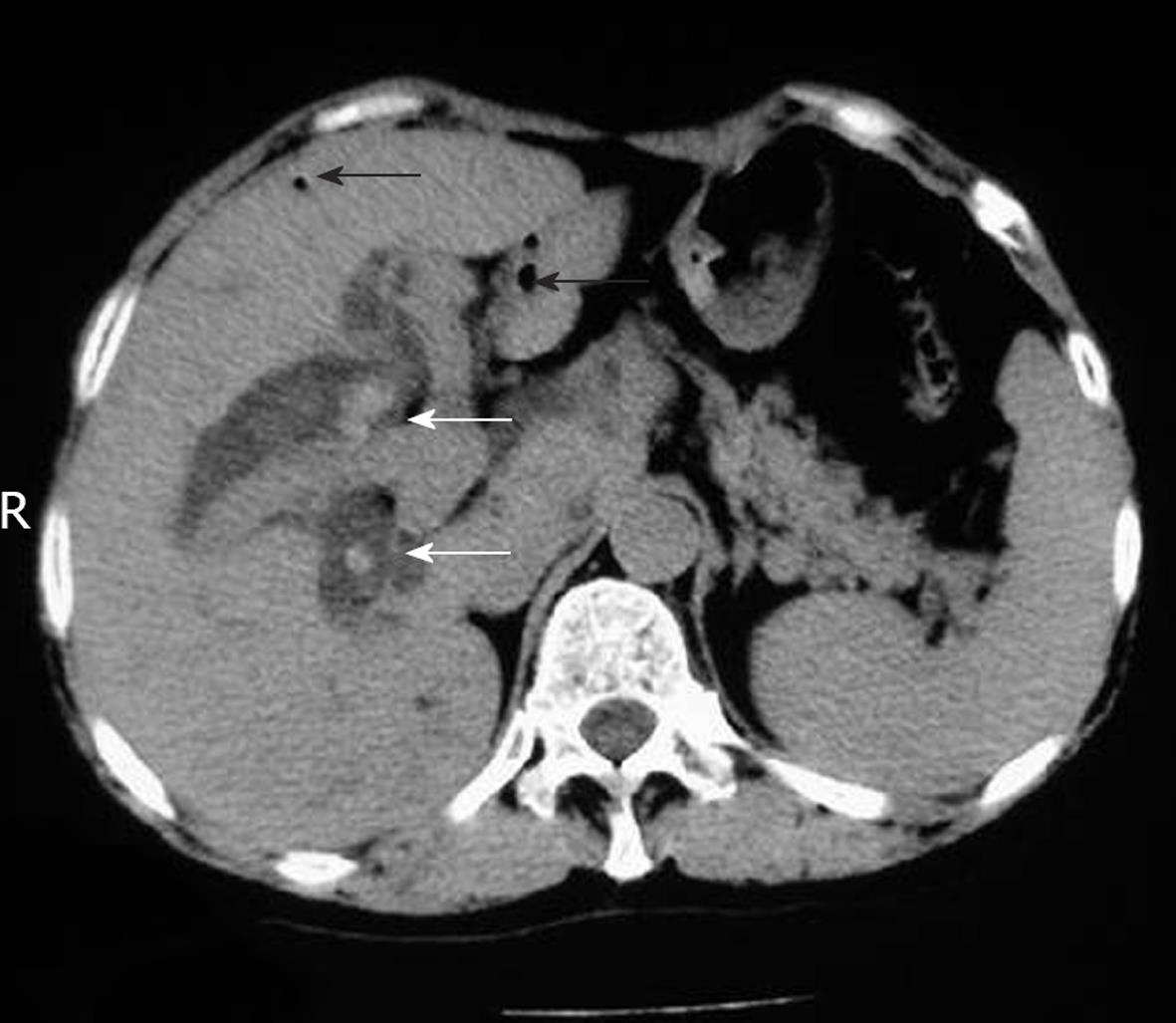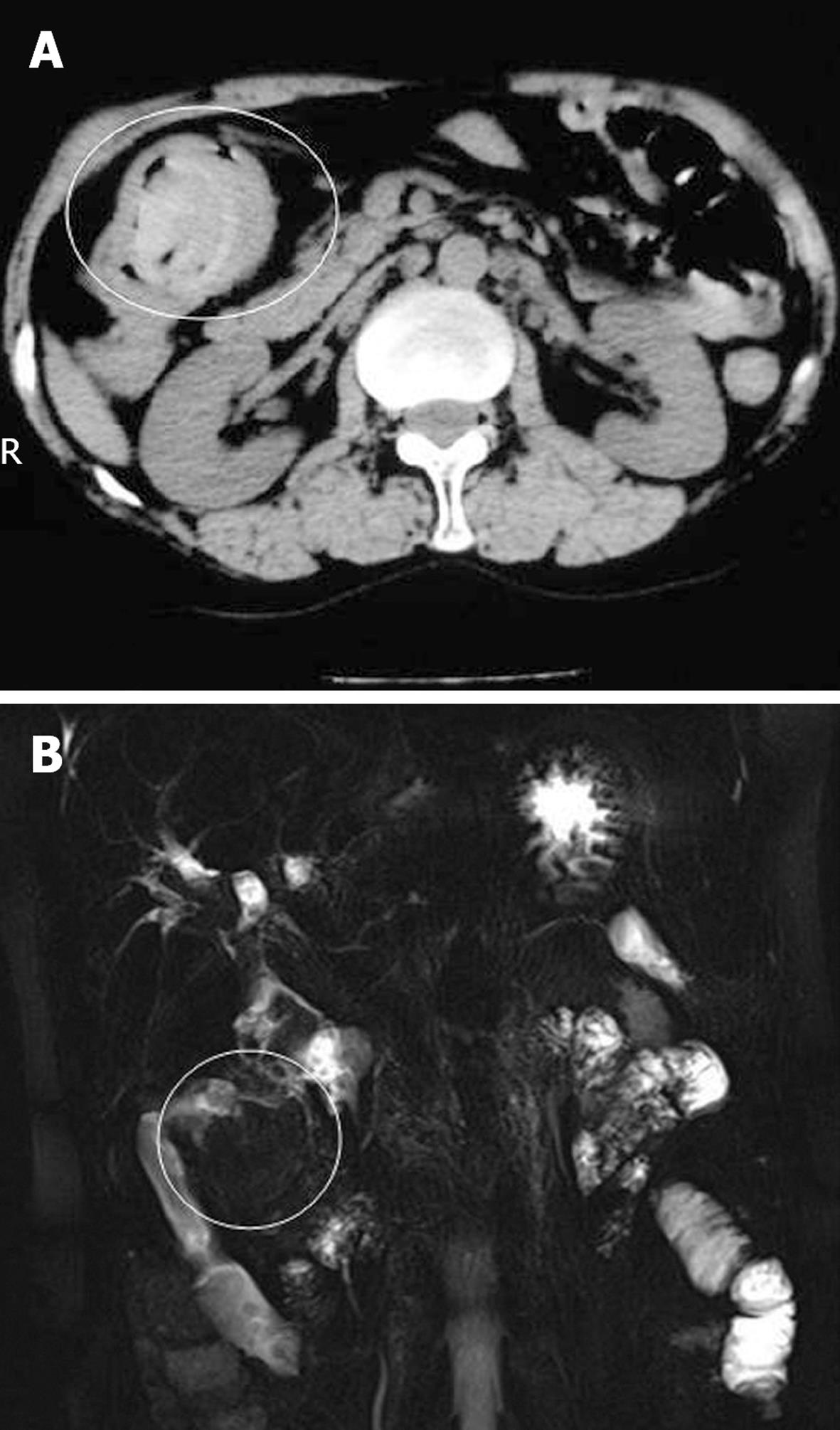Revised: December 20, 2010
Accepted: December 27, 2010
Published online: January 28, 2011
Roux-en-Y choledochojejunostomy is a common biliary reconstruction procedure. The collection of gallstones in the jejunal limb is a rare complication. Here we present a case of a 61-year-old Chinese female who received Roux-en-Y choledochojejunostomy 10 years ago. Diagnosis of recurrent bile duct stones accompanying infection was made before operation. She also had an abdominal mass which was possibly an intussuscepted colon or a huge fecolith. At laparotomy, an oval stone (5 cm in diameter) and 3 smaller multifaceted stones (2 cm in diameter) were found in the jejunal limb. A fistula between this jejunum and colon was also found. Although the typical manifestations of diarrhea were present, the diagnosis of a biliary colonic fistula was missed before operation. Partial colectomy was performed with the fistulous opening repaired. A T-tube was left in the jejunal limb and the mesocolon aperture was enlarged and revised. Her postoperative convalescence was uneventful. We report this case hoping to sharpen our diagnostic acumen.
- Citation: Suo T, Song LJ, Tong SX. Gallstone in jejunal limb with jejunocolonic fistula 10 years after Roux-en-Y choledochojejunostomy. World J Radiol 2011; 3(1): 38-40
- URL: https://www.wjgnet.com/1949-8470/full/v3/i1/38.htm
- DOI: https://dx.doi.org/10.4329/wjr.v3.i1.38
Roux-en-Y choledochojejunostomy is common procedure for biliary reconstruction. This procedure has early and late complications although it is effective and sometimes the only alternation[1,2]. The collection of gallstones in the jejunal limb is a rare complication[3]. Biliary colonic fistula is also one of rare complications following gallstone disease[4]. A fistula between reconstructed biliary tract and colon is hard to be recognized beforehand. Although diarrhea and infection may be claimed, they are typical but non-specific clinical manifestations.
Here we present a case of recurrent bile duct stones with infection and an abdominal mass in a 61-year-old female 10 years after Roux-en-Y choledochojejunostomy. A preoperatively missing biliary colonic fistula was found during operation.
A 61-year-old female complained of abdominal pain and unrelenting fever for 2 wk. She underwent cholecystectomy 10 years ago. Other details were not available. She had a mild vague right abdominal discomfort on and off after operation. About 2 years ago, her discomfort increased in intensity and turned into pain and became more frequent. Chills and high fever accompanied the episodes and she also developed chronic diarrhea, 6-8 motions a day, with scanty stools.
On examination, she appeared emaciated, pale and malnourished. Her temperature was 39°C, pulse rate 95/min, blood pressure 101/69 mmHg, and respiratory rate 18/min. She had no jaundice and the right upper rectus incision healed well. There was fullness of the right upper abdomen. A mass with vague margins was palpable with no significant muscle spasm. Her white blood cell count was 3100 per mm3 with 68.9% neutrophils, her hemoglobin and hematocrit values were 10.8 g/dL and 33.2%, respectively. Serum chemistry studies demonstrated that her total bilirubin was 21.1 μmol/L (normal range = 3.4-21.1 μmol/L), direct bilirubin 13.9 μmol/L (normal range < 6.8 μmol/L), alkaline phosphatase 335 U/L (normal range = 42-28 U/L), AST 71 U/L (normal range < 75 U/L), ALT 58 U/L (normal range < 75 U/L), albumin 28 g/L (normal range = 35-52 g/L), and prealbumin 0.17 g/L (normal range = 0.25-0.4 g/L). Imaging studies showed air (black arrows) and stones (white arrows) in the diffusely distended bile passages (Figure 1) and a mass or filling defect in the intestine (white circle) (Figure 2A and B).
A diagnosis of recurrent bile duct stones with infection was made. The abdominal mass was possibly an intussuscepted colon or a huge fecalith. She was managed conservatively and prepared for surgery.
At laparotomy, a Roux-en-Y choledochojejunostomy was found. The jejunal limb was markedly distended and intimately adhered to the hepatic flexure of the colon. A mass (5 cm in diameter) could be palpated in the jejunal limb. The ascending and transverse colons were mobilized with no tumor mass found. The jejunal limb was opened with an oval stone (5 cm in diameter) and 3 smaller multifaceted stones (2 cm in diameter) removed. The big stone was light yellow in color, stratified and loose in texture, with a 1.2 cm hard dark yellow kernel. The multifaceted stones were brown and hard, typical of mixed stones.
The hepatic ducts were patent with no stones observed during exploration with a choledochoscope and the bilioenteric anastomosis was 1.5 cm long. However, turbid yellowish fluid continuously oozed from the posterior wall of the jejunal limb. A fistula between the jejunum and colon was found with an opening about 2 cm in diameter. The adjacent bowel wall was not thickened. A frozen section biopsy of the colon mucosa showed only chronic inflammation.
The jejunal limb was 40 cm in length and compressed by a tight mesocolon aperture. A partial colectomy was performed with the fistulous opening repaired and reinforced using a piece of colon wall. A T-tube was left in the jejunal limb with the mesocolon aperture enlarged and revised. It is a pity that we did not take photos during the operation.
Her postoperative convalescence was uneventful except for a wound infection. Her diarrhea subsided and her general condition improved. A T-tube cholangiogram showed a patent bile passage with normal jejunal emptying functions 2 wk after operation. The patient took 5 tablets of Dan-Ning-Pian (traditional Chinese medicine) 3 times per day to prevent recurrence of the stone.
The significance of this report is the preoperative diagnostic challenge for gallstone in jejunal lim. The precise location of a huge stone detected on imaging studies before operation cannot be pin-pointed anatomically. Most observers made a diagnosis of a mass or filling defect in the colon. Due to the stratified structure of the mass, an intussusception of the colon cannot be excluded merely on unenhanced CT scanning. As intussusception or stercolith obstruction cannot be ruled out, surgery is usually performed.
Without any question, recurrent stones and infection were present in this case. Air in the biliary passage is an expected sequel of a bilioenteric anastomosis. However, in this case, a previous bilioenteric procedure was not known exactly. A huge stone in the jejunal limb was a surprise to all. To our knowledge, only 3 cases have been reported[3-5]. Although the typical manifestations of diarrhea and infection were present in our case, the diagnosis of a biliary colonic fistula was missed before operation as previously described[6]. It was only found on careful examination at operation. On the other hand, since the patient had not any evidence of colon obstruction, a diagnosis of possible obstruction due to intussusception or stercolith was completely groundless.
Roux-en-Y choledochojejunostomy is a common and effective procedure for biliary reconstruction. However, it is not without early and late complications. Reoperation may be necessary because of anastomotic stricture, calculi recurrence, biliary tract infection, or even malignant change[2]. Even though anastomotic stricture is relatively common after a bilioenteric procedure, this patient had not any stricture 10 years after Roux-en-Y choledochojejunostomy. Although collection of stones in the jejunal limb has been reported, to our knowledge, it is uncommon[3-5]. Such collection may be due to delayed emptying of the jejunal limb, because of motility dysfunction or mechanical obstruction because of torsion or kinking or compression of the limb by a tight mesocolon aperture. Poor emptying of the jejunal limb might have played an important role and a tight mesocolon aperture was the culprit in this case. Stasis caused the growth of the stone. Together with repeated infection, it finally led to formation of the jejunocolonic fistula.
Although a strictured anastomosis is the most frequent indication for reoperation after a Roux-en-Y bilioenteric procedure, one should also be on the alert for other conditions, such as motility dysfunction or inadequate patency as a cause for the delayed emptying of the jejunal limb. We report this case hoping to sharpen our diagnostic acumen.
Peer reviewer: Beat Schnüriger, MD, University of Southern California, Keck School of Medicine, Department of Surgery, Division of Acute Care Surgery, (Trauma, Emergency Surgery and Surgical Critical Care), 1200 North State Street, Inpatient Tower (C), 5th Floor, Room C5L100, Los Angeles, CA 90033-4525, United States
S- Editor Cheng JX L- Editor Wang XL E- Editor Zheng XM
| 1. | Röthlin MA, Löpfe M, Schlumpf R, Largiadèr F. Long-term results of hepaticojejunostomy for benign lesions of the bile ducts. Am J Surg. 1998;175:22-26. |
| 2. | Li Z, Cui N, Chen L. Treatment experience of subsequent complications after Roux-en-Y biliojejunostomy. Eur Surg Res. 2009;43:34-38. |
| 3. | Ajiki T, Suzuki Y, Okazaki T, Fujino Y, Yoshikawa T, Sawa H, Hirata K, Kuroda Y. A large stone detected in Roux-en-Y jejunal limb 20 years after excision of congenital choledochal cyst. Surgery. 2006;139:129-130. |
| 4. | Wada N, Seki M, Saikawa Y, Satoh M, Toizumi A, Tamura Y, Kageyama T, Otani Y, Kubota T, Kumai K. Jejunal limb obstruction caused by a cholesterol stone 15 years after a total gastrectomy and 20 years after a cholecystectomy: report of a case. Surg Today. 2000;30:181-184. |
| 5. | De Moor V, El Nakadi I, Jeanmart J, Gelin M, Donckier V. Cholangitis caused by Roux-en-Y hepaticojejunostomy obstruction by a biliary stone after liver transplantation. Transplantation. 2003;75:416-418. |
| 6. | Costi R, Randone B, Violi V, Scatton O, Sarli L, Soubrane O, Dousset B, Montariol T. Cholecystocolonic fistula: facts and myths. A review of the 231 published cases. J Hepatobiliary Pancreat Surg. 2009;16:8-18. |














